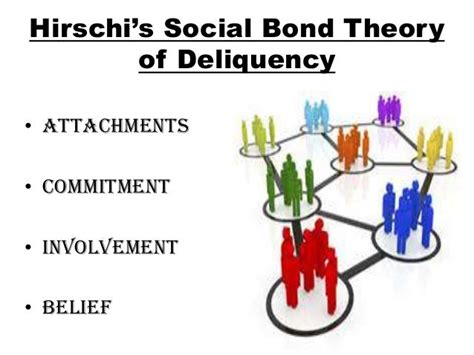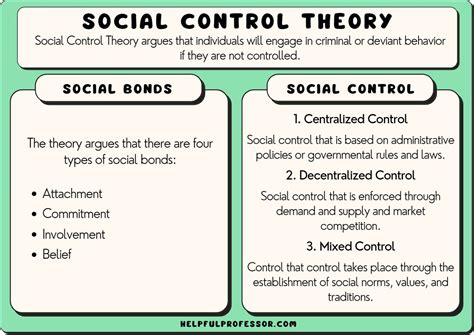Social control theory is a concept within the field of criminology that seeks to explain why individuals conform to societal norms and laws. Developed by Travis Hirschi in 1969, this theory posits that individuals are less likely to engage in delinquent behavior when they have strong bonds to their community, family, and institutions. These bonds are characterized by four main elements: attachment, commitment, involvement, and belief. Attachment refers to the emotional connection individuals have with others, commitment involves the investment individuals make in their relationships and community, involvement pertains to the level of participation in conventional activities, and belief relates to the acceptance of societal norms and values.
The theory suggests that when these bonds are weak or broken, individuals are more likely to engage in delinquent behavior. This is because they lack the restraint and guidance that strong social bonds provide. For instance, an individual who is strongly attached to their family and community is less likely to engage in criminal behavior because they fear disappointing their loved ones and damaging their relationships. Similarly, an individual who is committed to their education or career is less likely to engage in delinquent behavior because they have a stake in their future and understand the consequences of such actions.
Key Points
- Social control theory explains why individuals conform to societal norms and laws through strong bonds to their community, family, and institutions.
- The four main elements of social control are attachment, commitment, involvement, and belief.
- Weak or broken social bonds increase the likelihood of delinquent behavior.
- Strong social bonds provide restraint and guidance, reducing the likelihood of criminal behavior.
- The theory emphasizes the importance of social relationships and institutions in shaping individual behavior.
Theoretical Foundations

Social control theory is rooted in the idea that human behavior is shaped by the social environment. The theory draws on the work of Émile Durkheim, who argued that social solidarity and cohesion are essential for maintaining social order. Hirschi’s theory builds on this foundation by identifying the specific mechanisms through which social control operates. By examining the ways in which social bonds influence behavior, social control theory provides a nuanced understanding of the complex factors that contribute to delinquency and crime.
Attachment and Commitment
Attachment and commitment are two critical components of social control theory. Attachment refers to the emotional bonds individuals form with others, such as family members, friends, and community leaders. When individuals are strongly attached to others, they are more likely to conform to societal norms and laws because they fear disappointing those they care about. Commitment, on the other hand, involves the investments individuals make in their relationships and community. This can include investments in education, career, or other activities that provide a sense of purpose and fulfillment. When individuals are committed to their relationships and community, they are less likely to engage in delinquent behavior because they have a stake in their future and understand the consequences of such actions.
| Element of Social Control | Description |
|---|---|
| Attachment | Emotional bonds with others, such as family and friends |
| Commitment | Investments in relationships and community, such as education and career |
| Involvement | Participation in conventional activities, such as hobbies and sports |
| Belief | Acceptance of societal norms and values |

Empirical Evidence and Criticisms

Social control theory has been extensively tested and supported by empirical research. Studies have consistently shown that individuals with strong social bonds are less likely to engage in delinquent behavior. For example, a study by Sampson and Laub (1993) found that boys who were strongly attached to their families and communities were less likely to engage in delinquent behavior. However, the theory has also been subject to criticisms and challenges. Some critics argue that the theory is too narrow, failing to account for the role of structural factors, such as poverty and inequality, in shaping behavior. Others argue that the theory is too broad, failing to provide a clear explanation of the mechanisms through which social control operates.
Policy Implications
Social control theory has significant implications for crime prevention and intervention strategies. By targeting the social bonds that influence behavior, policymakers and practitioners can develop more effective programs to reduce delinquency and crime. For example, programs that aim to strengthen family relationships, such as family therapy and parenting programs, can help to reduce delinquency by increasing attachment and commitment. Similarly, programs that provide opportunities for community involvement, such as after-school programs and community service, can help to reduce delinquency by increasing involvement and belief in societal norms and values.
What is social control theory?
+Social control theory is a concept within the field of criminology that explains why individuals conform to societal norms and laws through strong bonds to their community, family, and institutions.
What are the four main elements of social control?
+The four main elements of social control are attachment, commitment, involvement, and belief.
How does social control theory explain delinquency?
+Social control theory explains delinquency as a result of weak or broken social bonds. When individuals lack strong bonds to their community, family, and institutions, they are more likely to engage in delinquent behavior.
In conclusion, social control theory provides a nuanced understanding of the complex factors that contribute to delinquency and crime. By examining the ways in which social bonds influence behavior, the theory offers a framework for developing effective crime prevention and intervention strategies. While the theory has been subject to criticisms and challenges, it remains a significant contribution to the field of criminology, highlighting the importance of social relationships and institutions in shaping individual behavior.



